Code of Silence
The history of New York City is a very popular topic these days. On Facebook, pages dedicated to old photos have hundreds, sometimes thousands of “Likes.” That was one of the reasons for choosing my topic for the Auld Irishtown trilogy here at artofneed. That along with my own personal interest.
In many cases, very detailed information about neighborhoods can bring on loads of interest. Over the next few weeks, I’ll be posting regular posts about one such neighborhood in Brooklyn: Irishtown. A name that doesn’t even exist any longer. Instead, we know it as its original name: Vinegar Hill. But at one point in time it was loaded with the Irish that were so poor and so destitute that they couldn’t travel any further than the ports that berthed them. Irishtown was such a place, and although Manhattan’s Five Points is more famous, we’ll compare and contrast the two throughout this series, for they had one major difference between them: The Code of Silence that existed in Irishtown. Which is the topic of this first installment. Hope you enjoy:
The Code of Silence
“That alley was the most turbulent spot in Irishtown,” so said a man who called himself the Gas Drip Bard in an 1899 edition of the Brooklyn Daily Eagle about a dangerous place off Gold Street in the mid 1800s. “It would be worth a policeman’s life to enter there after dark, or for that matter in the daylight.”
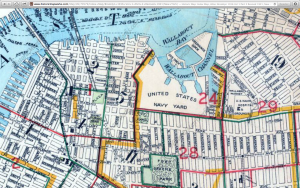
The old Fifth Ward was where Irishtown was located. In this photo circa 1916, it is right of the Manhattan Bridge, left of the Navy Yard.
Irishtown was located in the old Fifth Ward of Brooklyn. Along the waterfront west of the Navy Yard, east of where the Manhattan Bridge now reaches into the sky. And although it was not as well known as Manhattan’s Five Points of mid 19th Century New York fame, it was equally as notorious and filled to the limit with the same desperate, Famine Irish.
In fact, according to the Census for the State of New York for 1855, in an equally dense area, Irishtown had 5,629 Irish-born among its total population of 16,000. Five Points, according to Tyler Anbinder, Manhattan historian and author of a book on the infamous Five Points, “(had) about 7,200 that were Irish-born” out of a total 14,000 in 1855.
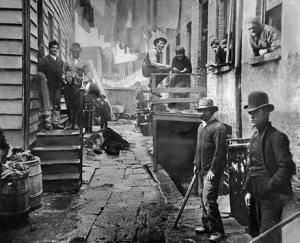
Five Points, known worldwide as the most dangerous neighborhood in New York, was the Miley Cyrus of slums, whereas Irishtown was the JD Salinger of them.
But if Five Points was known far and wide, even internationally for being disease-ridden, filled with prostitution and gambling rings and murderers and gangs… Brooklyn’s Irishtown was known for, well, keeping its secrets.
So desperate were they to keep the law and outsiders away, Irishtown residents took to the rooftops in the early 1870s to hurl streetwise chimney bricks and paving stones at police and federal agents. After many years of attempting to stop the plethora of untaxed, illegal whiskey distilleries in Irishtown, the city was forced to summon the United States Marines through the Navy Yard in an early morning raid in July, 1873.
“A code of silence was observed in Irishtown,” explained New York’s most famous bank robber and Irishtown native Willie Sutton (born 1901) in his biography. “More faithfully than Omerta is observed by the mafia… It wasn’t only the gangs that were at war with the police, everybody was. If a man was arrested, his whole family would run alongside the paddy wagon screaming… All the police ever got out of him was the exercise. Nobody ever talked in Irishtown.”
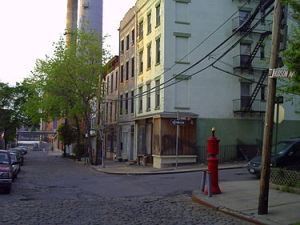
Here is a photo of what is left of Irishtown/Vinegar Hill. Most of it has been torn down and rebuilt by now, sadly.
These were not rioters in Irishtown, as there were in Five Points ten years earlier during the civil war draft. These were men and women and children that banned together to keep the law out. A commune, almost. But protected violently.
That morning in 1873 has been described in some detail in multiple periodicals of the time. Other articles were written years afterward commemorating what was seen as a symbolic event in Irishtown’s need to keep the police out. When the government is forced to summon the likes of the Marines to put order in a neighborhood, well, that’s pretty remarkable.
For this reason, the code of silence, Irishtown has not received the recognition that Five Points has. There was even a gang that named itself the Five Points Gang (Italian gang of Mulberry Street after the area had been mostly razed). In 2002, an entire movie by Martin Scorcese was based on Five Points.
Like so many Brooklynites have been in the position of doing, Irishtown looked upon the Five Points area with a bit of jealousy, but also with a lowered eye since it seemed everyone over there was out for themselves. To the people of Irishtown, Five Pointers were so selfish that they had no sense of community. Isn’t it the point to keep the coppers out? What it shared in ethnic inhabitants, it contrasted entirely in character.
Many years later in 1923, a gangster in the White Hand Gang named “Wild” Bill Lovett was gunned down on Front Street in Irishtown. Instead of looking to the law for justice, he was quoted as saying, “I got mine. Don’t ask any questions. Don’t try to pump me. It’s give and take. When we get it, we take it and say nothing.”
Not long afterward, another Irish native named Eddie Hughes who was suspected of the original shooting of Lovett, was murdered. But with no witnesses (as usual), no one could be charged.
By that time, of course, refusal to speak with the police was tradition. A tradition in Irishtown that reached back even further in the sensibilities of all those that ended up in Irishtown BECAUSE of law.
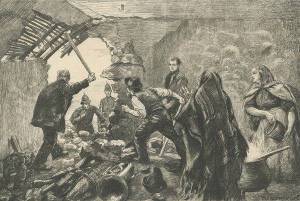
A gripping look at a family refusing eviction at the hands of the British police during the famine. A very stirring scenario for most Irish-Americans where the walls were often ripped down and the thatch roof set alight so they couldn’t return.
Back in Ireland in the 1840s, a blight on the staple of the Irish diet, the potato, was used by the British government as a way to remove the tenant farmers from their lands and replace them with a cash crop in cattle. (This argument has gained steam over the years and there are many Irish and Irish-Americans that are dedicated to changing the description of this even from “Famine” to “Genocide,” but let’s stick to the topic here).
The Irish tenant farmer had a tradition of refusing to pay rent. Supported by their secret societies and more interested in their own factions than any foreign occupiers, the Irish were a rebellious lot that made the British colonial landlords boil in anger, due their tenants’ refusal to go along with their laws.
Along came the blight and with a half-hearted and smarmy policy toward it, allowed, often paid for these Irish peasants to be sent in “coffin ships” to places like Brooklyn, New York. At least, those who survived long enough to board the ships. And, those who survived the long journeys.
Over a million died of starvation. Two million more emigrated from a very small island nation. If we were able to go back in time and ask those survivors of the Great Hunger what they felt about law? As it was law, in their eyes, that was manipulated to create such a horrific scenario? Well, what do you think they’d say about it?
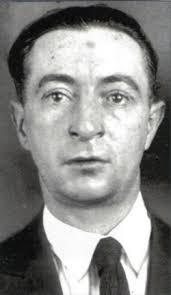
Seen here in 1922, Wild Bill Lovett was no believer in the American dream. He wanted to only to be known as the king of his neighborhood and the dock rackets along the heavily industrialized Brooklyn waterfront.
In 1923, Wild Bill Lovett, an Irish American himself, was merely lending his life to the Irish tradition of the code of silence. He was happy to live and die knowing that the police and the Anglo-American laws they enforced had no say in it. Later that same year he did die, in fact, hatcheted in the skull and shot in the neck by, you might’ve guessed it by now, unknown assailants.
Silence was Irishtown’s way of keeping their own traditions. Making their own stories outside of the over-arching Anglo-American culture. The conflicts and the faction fighting in their lives kept within their own borders of Bridge Street and the wall at the Navy Yard.
Like the famous Irish revolutionary Michael Collins said in the movie, “There is one weapon that the British cannot take away from us: we can ignore them.”
Maybe later we’ll talk about Brehon Law, a civil code based on honor that Ireland lived by before the British outlawed it along with the Irish language and, just to make sure they understood who was boss, disallowed anyone perform Catholic Mass anywhere in the isle of Ireland.
Until then, however, look for another post in a few days about Auld Irishtown.





